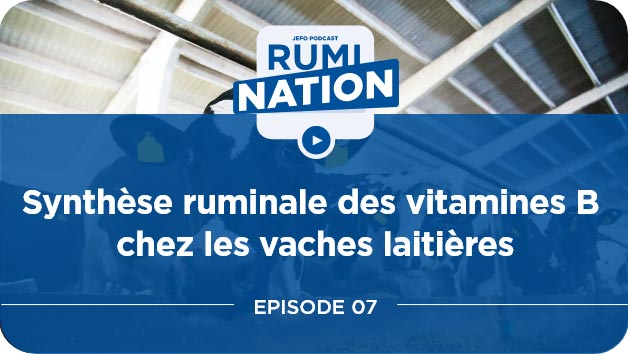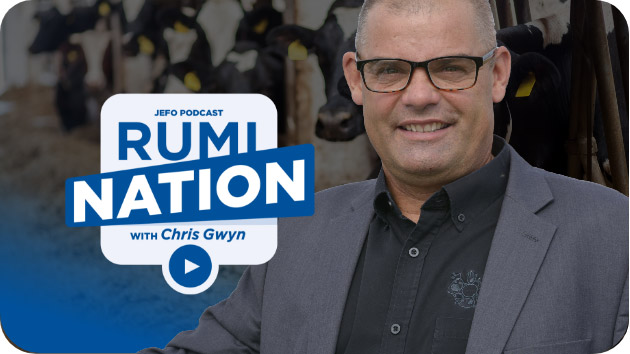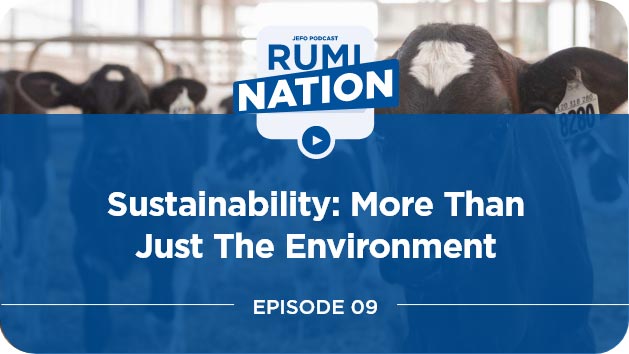RumiNation | S03 : E08
Digging Into Early Life Nutrition for Dairy Calves
Brought to you by Jefo Nutrition
Share now!
Did you enjoy this episode?
Share now!
Our guest - Dr. Michael Steele
Professor at the Ontario Agricultural College, Department of Animal Biosciences
Dr. Steele is an expert in dairy cattle physiology and nutrition. He is especially interested in the health, production efficiency, and development of dairy calves and young ruminants.

Timestamps & Summary
1:49
I believe the audience would really enjoy hearing about your journey as a young Oxford county dairy producer all the way to a university professor.
Dr. Michael Steele
I grew up in Oxford County, and Ontario, Canada, and I have loved the dairy cow for my entire life.
I went to the University of Guelph thinking I was going to become a geneticist. Then, I took fundamentals of nutrition and physiology, and that was it. I knew that is where I wanted to focus my energy.
The drive for research brought me to a PhD at the University of Guelph as well. I also had the opportunity to work for private industry before and after my PhD, which was great for me.
I was lucky enough to have a position at the University of Alberta, just over eight years ago. That is when I started my academic career.
I used to study transition cows and ruminal acidosis, but I switched to calf research.
I was very happy to return to Ontario, here at the University of Guelph, where I have been for over three years now.
Being a professor is amazing. I’m always surrounded by ideas and young people. So I’m very happy with where I am career wise. But I do admit I do miss milking cows.
4:06
A paper you coauthored highlighted several key windows of developmental programming opportunity that exists in young and developing ruminants, in which perhaps managing nutrition, whether it’s in utero, all the way up to calving can contribute to the development of those calves and those heifers and ultimately, improved milk production efficiency and health. Could you tell us more?
Dr. Michael Steele
The focus of calf research over the last 50 years has been on colostrum feeding and milk feeding and a little bit on weaning as well. These are important periods of the calf’s life. Developmental plasticity or that ability for that calf to change and be programmed is high at that time, and we have been shown on that wide variety of research experiments that if you increase growth and health during this critical window, you can improve overall production for a lifetime.
Before that calf is born, there is a lot of programming happening. We want to learn more about how feeding the dam affects the calf and following these animals for their entire life. I think that is a critical piece to understand how this early life interventions or early nutrition can affect lifetime performance.
6:04
What should we be doing differently today to enhance performance and minimize stress during those periods?
Dr. Michael Steele
I think it all starts on the first day of life with colostrum. A lot of our research has shown that some of the recommendations we have today are still not ideal. Ten years ago, it was 100 grams of IgG and colostrum in that first meal. Now we are at 150, some people are saying 200. I think our lab has produced results, saying that it is actually double that. So, I think we have still a lot to learn with respect to colostrum management and also that transition from colostrum to milk happening in that first week of life. I think that is something that we have really focused on just showing what that does to the calf with respect to health in, in gut function.
8:01
You talked about intestinal development, gut health development in the colostrum period, as well as the weaning transition. Could you expand a bit more on that and the development and physiology of the rumen and lower gut during that transition?
Dr. Michael Steele
Maintaining proper gut health is critical for this calf.
If you look at the morbidity and mortality, it is really stemming from gastrointestinal dysfunction and pathogenic diarrhea. So, anything we can do to improve the gastrointestinal microbial community, as well as the health and barrier function can have a positive impact on this calf.
We have been looking at different colostrum feeding strategies like extended colostrum feeding, looking at different milk compositions, really focusing on fatty acid composition within the milk, as well as lactose concentrations to see how that affects gastrointestinal health.
It looks like some of the things that we were doing naturally in management, like an abrupt transition from colostrum to a whole milk, or feeding milk replacers that are high in lactose could actually stimulate some gut dysfunction during this pre-weaning period. Some of our recent research has really challenged some of the dogma that we have in our industry of how to feed a calf in the first day of life and even during this entire pre-weaning period.
12:13
Back to some of the things you mentioned about colostrum feeding and transition milk. Those would be some things that could be implemented today, right?
Dr. Michael Steele
Absolutely. I think just feeding as much colostrum as the calf can consume is the takeaway. But, if you’re limited through economics, then I would be shooting for over 200 grams, but even closer to 300 grams of immunoglobulins. Making sure you have a gradual transition from that colostrum to a whole milk or milk replacer. Feeding a lot of milk and milk replacer in the first three to four weeks is what I would recommend because they do not consume starter, at least enough starter to grow. Then having this really gradual and late weaning program on farm, so after eight weeks of life, and trying to have a step-down program of close to two weeks or even longer, I think those would be my big take-home messages for your audience today.







